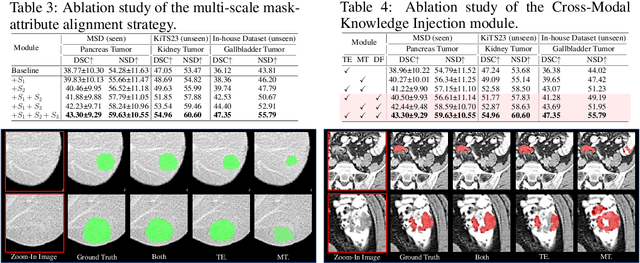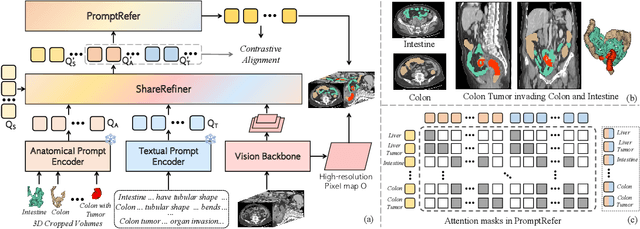Yankai Jiang
SCP: Accelerating Discovery with a Global Web of Autonomous Scientific Agents
Dec 30, 2025Abstract:We introduce SCP: the Science Context Protocol, an open-source standard designed to accelerate discovery by enabling a global network of autonomous scientific agents. SCP is built on two foundational pillars: (1) Unified Resource Integration: At its core, SCP provides a universal specification for describing and invoking scientific resources, spanning software tools, models, datasets, and physical instruments. This protocol-level standardization enables AI agents and applications to discover, call, and compose capabilities seamlessly across disparate platforms and institutional boundaries. (2) Orchestrated Experiment Lifecycle Management: SCP complements the protocol with a secure service architecture, which comprises a centralized SCP Hub and federated SCP Servers. This architecture manages the complete experiment lifecycle (registration, planning, execution, monitoring, and archival), enforces fine-grained authentication and authorization, and orchestrates traceable, end-to-end workflows that bridge computational and physical laboratories. Based on SCP, we have constructed a scientific discovery platform that offers researchers and agents a large-scale ecosystem of more than 1,600 tool resources. Across diverse use cases, SCP facilitates secure, large-scale collaboration between heterogeneous AI systems and human researchers while significantly reducing integration overhead and enhancing reproducibility. By standardizing scientific context and tool orchestration at the protocol level, SCP establishes essential infrastructure for scalable, multi-institution, agent-driven science.
Incentivizing Tool-augmented Thinking with Images for Medical Image Analysis
Dec 16, 2025Abstract:Recent reasoning based medical MLLMs have made progress in generating step by step textual reasoning chains. However, they still struggle with complex tasks that necessitate dynamic and iterative focusing on fine-grained visual regions to achieve precise grounding and diagnosis. We introduce Ophiuchus, a versatile, tool-augmented framework that equips an MLLM to (i) decide when additional visual evidence is needed, (ii) determine where to probe and ground within the medical image, and (iii) seamlessly weave the relevant sub-image content back into an interleaved, multimodal chain of thought. In contrast to prior approaches limited by the performance ceiling of specialized tools, Ophiuchus integrates the model's inherent grounding and perception capabilities with external tools, thereby fostering higher-level reasoning. The core of our method is a three-stage training strategy: cold-start training with tool-integrated reasoning data to achieve basic tool selection and adaptation for inspecting key regions; self-reflection fine-tuning to strengthen reflective reasoning and encourage revisiting tool outputs; and Agentic Tool Reinforcement Learning to directly optimize task-specific rewards and emulate expert-like diagnostic behavior. Extensive experiments show that Ophiuchus consistently outperforms both closed-source and open-source SOTA methods across diverse medical benchmarks, including VQA, detection, and reasoning-based segmentation. Our approach illuminates a path toward medical AI agents that can genuinely "think with images" through tool-integrated reasoning. Datasets, codes, and trained models will be released publicly.
TK-Mamba: Marrying KAN with Mamba for Text-Driven 3D Medical Image Segmentation
May 24, 2025



Abstract:3D medical image segmentation is vital for clinical diagnosis and treatment but is challenged by high-dimensional data and complex spatial dependencies. Traditional single-modality networks, such as CNNs and Transformers, are often limited by computational inefficiency and constrained contextual modeling in 3D settings. We introduce a novel multimodal framework that leverages Mamba and Kolmogorov-Arnold Networks (KAN) as an efficient backbone for long-sequence modeling. Our approach features three key innovations: First, an EGSC (Enhanced Gated Spatial Convolution) module captures spatial information when unfolding 3D images into 1D sequences. Second, we extend Group-Rational KAN (GR-KAN), a Kolmogorov-Arnold Networks variant with rational basis functions, into 3D-Group-Rational KAN (3D-GR-KAN) for 3D medical imaging - its first application in this domain - enabling superior feature representation tailored to volumetric data. Third, a dual-branch text-driven strategy leverages CLIP's text embeddings: one branch swaps one-hot labels for semantic vectors to preserve inter-organ semantic relationships, while the other aligns images with detailed organ descriptions to enhance semantic alignment. Experiments on the Medical Segmentation Decathlon (MSD) and KiTS23 datasets show our method achieving state-of-the-art performance, surpassing existing approaches in accuracy and efficiency. This work highlights the power of combining advanced sequence modeling, extended network architectures, and vision-language synergy to push forward 3D medical image segmentation, delivering a scalable solution for clinical use. The source code is openly available at https://github.com/yhy-whu/TK-Mamba.
Advancing Generalizable Tumor Segmentation with Anomaly-Aware Open-Vocabulary Attention Maps and Frozen Foundation Diffusion Models
May 05, 2025Abstract:We explore Generalizable Tumor Segmentation, aiming to train a single model for zero-shot tumor segmentation across diverse anatomical regions. Existing methods face limitations related to segmentation quality, scalability, and the range of applicable imaging modalities. In this paper, we uncover the potential of the internal representations within frozen medical foundation diffusion models as highly efficient zero-shot learners for tumor segmentation by introducing a novel framework named DiffuGTS. DiffuGTS creates anomaly-aware open-vocabulary attention maps based on text prompts to enable generalizable anomaly segmentation without being restricted by a predefined training category list. To further improve and refine anomaly segmentation masks, DiffuGTS leverages the diffusion model, transforming pathological regions into high-quality pseudo-healthy counterparts through latent space inpainting, and applies a novel pixel-level and feature-level residual learning approach, resulting in segmentation masks with significantly enhanced quality and generalization. Comprehensive experiments on four datasets and seven tumor categories demonstrate the superior performance of our method, surpassing current state-of-the-art models across multiple zero-shot settings. Codes are available at https://github.com/Yankai96/DiffuGTS.
Towards All-in-One Medical Image Re-Identification
Mar 11, 2025Abstract:Medical image re-identification (MedReID) is under-explored so far, despite its critical applications in personalized healthcare and privacy protection. In this paper, we introduce a thorough benchmark and a unified model for this problem. First, to handle various medical modalities, we propose a novel Continuous Modality-based Parameter Adapter (ComPA). ComPA condenses medical content into a continuous modality representation and dynamically adjusts the modality-agnostic model with modality-specific parameters at runtime. This allows a single model to adaptively learn and process diverse modality data. Furthermore, we integrate medical priors into our model by aligning it with a bag of pre-trained medical foundation models, in terms of the differential features. Compared to single-image feature, modeling the inter-image difference better fits the re-identification problem, which involves discriminating multiple images. We evaluate the proposed model against 25 foundation models and 8 large multi-modal language models across 11 image datasets, demonstrating consistently superior performance. Additionally, we deploy the proposed MedReID technique to two real-world applications, i.e., history-augmented personalized diagnosis and medical privacy protection. Codes and model is available at \href{https://github.com/tianyuan168326/All-in-One-MedReID-Pytorch}{https://github.com/tianyuan168326/All-in-One-MedReID-Pytorch}.
A Data-Efficient Pan-Tumor Foundation Model for Oncology CT Interpretation
Feb 10, 2025



Abstract:Artificial intelligence-assisted imaging analysis has made substantial strides in tumor diagnosis and management. Here we present PASTA, a pan-tumor CT foundation model that achieves state-of-the-art performance on 45 of 46 representative oncology tasks -- including lesion segmentation, tumor detection in plain CT, tumor staging, survival prediction, structured report generation, and cross-modality transfer learning, significantly outperforming the second-best models on 35 tasks. This remarkable advancement is driven by our development of PASTA-Gen, an innovative synthetic tumor generation framework that produces a comprehensive dataset of 30,000 CT scans with pixel-level annotated lesions and paired structured reports, encompassing malignancies across ten organs and five benign lesion types. By leveraging this rich, high-quality synthetic data, we overcome a longstanding bottleneck in the development of CT foundation models -- specifically, the scarcity of publicly available, high-quality annotated datasets due to privacy constraints and the substantial labor required for scaling precise data annotation. Encouragingly, PASTA demonstrates exceptional data efficiency with promising practical value, markedly improving performance on various tasks with only a small amount of real-world data. The open release of both the synthetic dataset and PASTA foundation model effectively addresses the challenge of data scarcity, thereby advancing oncological research and clinical translation.
A Survey of Embodied AI in Healthcare: Techniques, Applications, and Opportunities
Jan 13, 2025



Abstract:Healthcare systems worldwide face persistent challenges in efficiency, accessibility, and personalization. Powered by modern AI technologies such as multimodal large language models and world models, Embodied AI (EmAI) represents a transformative frontier, offering enhanced autonomy and the ability to interact with the physical world to address these challenges. As an interdisciplinary and rapidly evolving research domain, "EmAI in healthcare" spans diverse fields such as algorithms, robotics, and biomedicine. This complexity underscores the importance of timely reviews and analyses to track advancements, address challenges, and foster cross-disciplinary collaboration. In this paper, we provide a comprehensive overview of the "brain" of EmAI for healthcare, wherein we introduce foundational AI algorithms for perception, actuation, planning, and memory, and focus on presenting the healthcare applications spanning clinical interventions, daily care & companionship, infrastructure support, and biomedical research. Despite its promise, the development of EmAI for healthcare is hindered by critical challenges such as safety concerns, gaps between simulation platforms and real-world applications, the absence of standardized benchmarks, and uneven progress across interdisciplinary domains. We discuss the technical barriers and explore ethical considerations, offering a forward-looking perspective on the future of EmAI in healthcare. A hierarchical framework of intelligent levels for EmAI systems is also introduced to guide further development. By providing systematic insights, this work aims to inspire innovation and practical applications, paving the way for a new era of intelligent, patient-centered healthcare.
Unleashing the Potential of Vision-Language Pre-Training for 3D Zero-Shot Lesion Segmentation via Mask-Attribute Alignment
Oct 21, 2024



Abstract:Recent advancements in medical vision-language pre-training models have driven significant progress in zero-shot disease recognition. However, transferring image-level knowledge to pixel-level tasks, such as lesion segmentation in 3D CT scans, remains a critical challenge. Due to the complexity and variability of pathological visual characteristics, existing methods struggle to align fine-grained lesion features not encountered during training with disease-related textual representations. In this paper, we present Malenia, a novel multi-scale lesion-level mask-attribute alignment framework, specifically designed for 3D zero-shot lesion segmentation. Malenia improves the compatibility between mask representations and their associated elemental attributes, explicitly linking the visual features of unseen lesions with the extensible knowledge learned from previously seen ones. Furthermore, we design a Cross-Modal Knowledge Injection module to enhance both visual and textual features with mutually beneficial information, effectively guiding the generation of segmentation results. Comprehensive experiments across three datasets and 12 lesion categories validate the superior performance of Malenia. Codes will be publicly available.
LLM Inference Serving: Survey of Recent Advances and Opportunities
Jul 17, 2024Abstract:This survey offers a comprehensive overview of recent advancements in Large Language Model (LLM) serving systems, focusing on research since the year 2023. We specifically examine system-level enhancements that improve performance and efficiency without altering the core LLM decoding mechanisms. By selecting and reviewing high-quality papers from prestigious ML and system venues, we highlight key innovations and practical considerations for deploying and scaling LLMs in real-world production environments. This survey serves as a valuable resource for LLM practitioners seeking to stay abreast of the latest developments in this rapidly evolving field.
CAT: Coordinating Anatomical-Textual Prompts for Multi-Organ and Tumor Segmentation
Jun 11, 2024



Abstract:Existing promptable segmentation methods in the medical imaging field primarily consider either textual or visual prompts to segment relevant objects, yet they often fall short when addressing anomalies in medical images, like tumors, which may vary greatly in shape, size, and appearance. Recognizing the complexity of medical scenarios and the limitations of textual or visual prompts, we propose a novel dual-prompt schema that leverages the complementary strengths of visual and textual prompts for segmenting various organs and tumors. Specifically, we introduce CAT, an innovative model that Coordinates Anatomical prompts derived from 3D cropped images with Textual prompts enriched by medical domain knowledge. The model architecture adopts a general query-based design, where prompt queries facilitate segmentation queries for mask prediction. To synergize two types of prompts within a unified framework, we implement a ShareRefiner, which refines both segmentation and prompt queries while disentangling the two types of prompts. Trained on a consortium of 10 public CT datasets, CAT demonstrates superior performance in multiple segmentation tasks. Further validation on a specialized in-house dataset reveals the remarkable capacity of segmenting tumors across multiple cancer stages. This approach confirms that coordinating multimodal prompts is a promising avenue for addressing complex scenarios in the medical domain.
 Add to Chrome
Add to Chrome Add to Firefox
Add to Firefox Add to Edge
Add to Edge